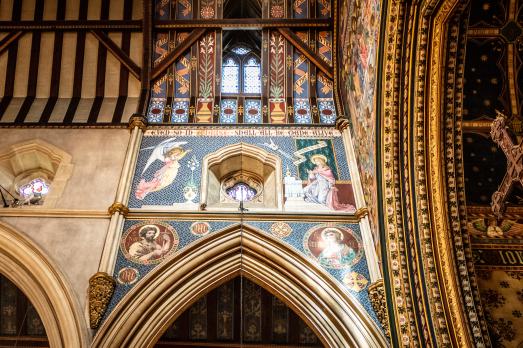The church was founded by Thomas Gambier Parry of Highnam Court. The work was begun in 1848 with Henry Woodyer as architect. The church was consecrated 21 months later in April 1851. The theme throughout is children.
The craftsmanship throughout the church is exceptional, and no expense was spared by its founder. The windows capture one’s attention. Those in the nave are by two different craftsmen. On the south side they were designed by Pugin and made by Hardman, and on the North side by William Wailes. The large east window was designed by Clayton & Bell.
The floor tiles, made by Minton, become increasingly more ornate as you near the altar. The screen, the lofty canopy over the font and the cherubs on the end of the pews of the choir stalls demonstrate the skills of the woodworkers. The brass candelabra, the radiator covers, the lectern and the ornate screens to the side chapel show details of metalwork.
The Wall Paintings were designed and painted by Thomas Gambier Parry, inspired by the wall paintings he had seen on his travels in Italy. He used a spirit fresco technique, which he had developed. He mixed his own paints. Assistants only did the lettering and diaper patterns. Along whole of the south wall is a depiction of the Palm Sunday procession into Jerusalem.
Over the chancel arch the painting represents the Last Judgement. In the centre the Son of Man is seated, with the twelve apostles on each side. Matthias’ face at the extreme right cannot be seen, according to convention. He is obscured by the arm of Moses who is holding the tablets of the Ten Commandments. To the left stands St Paul.




